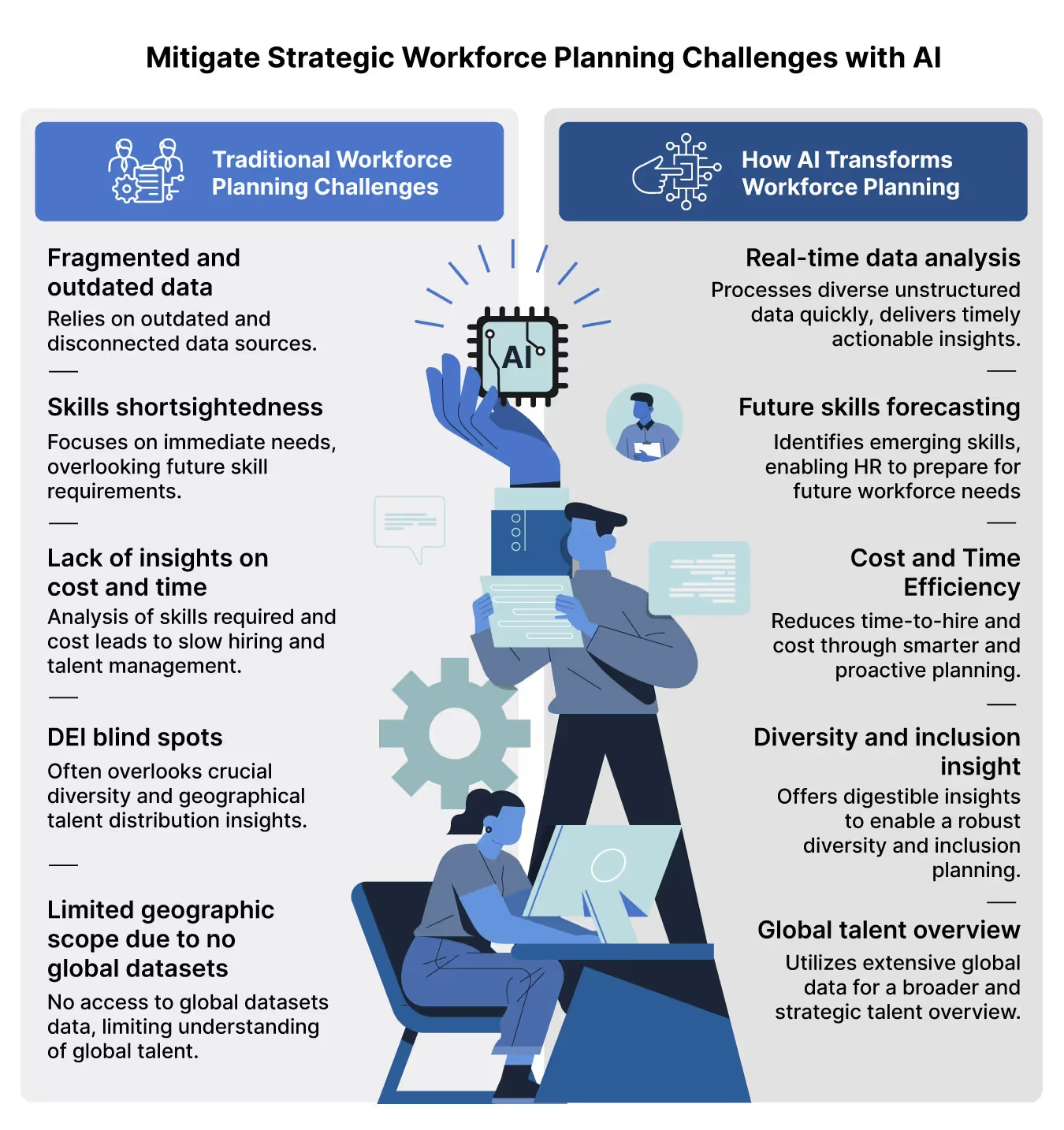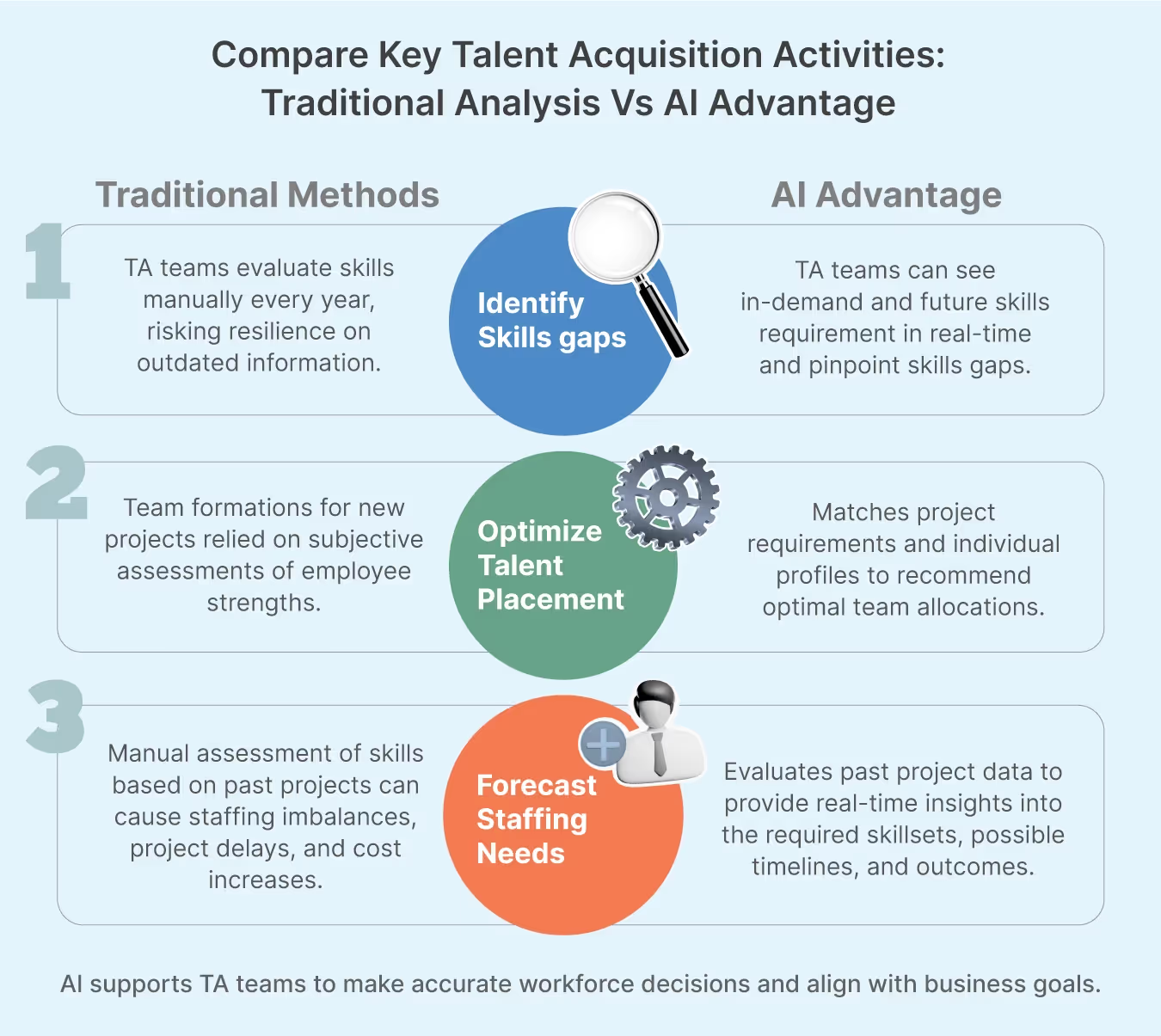AI is Fast-Tracking Strategic Workforce Planning & Transforming Talent Management
Analyze talent trends, Identify skills gaps, Determine future workforce needs, and more!
53% of HR leaders think AI will help them find skills gaps in their workforce.
Finding and bringing skills gap is an important part of the annual strategic workforce planning exercise. It also involves assessing future needs to acquire future skills.
Talent stakeholders meet annually to discuss and assess talent needs, hiring goals, and timelines. Although many companies plan their workforce this way, this process has challenges; let us explain.

Strategic Workforce Planning and Talent Management
The Challenges
Let us look at some of the common strategic workforce planning challenges.
- Fragmented and outdated data
It stems from the use of multiple and disconnected data sources, resulting in data silos which are often not updated.
The lack of a comprehensive and accurate view of the latest insight makes HR unable to make strategic decisions that solve current and future business disruptions.
In large organizations where growth through mergers and acquisitions is commonplace, this strategic workforce planning challenge is amplified due to the use of disparate systems across businesses.
- Skills shortsightedness:
This occurs when HR’s primary focus is on the current workforce needs while overlooking the skills employees will require as technologies and job roles evolve.
This oversight can leave companies unprepared for disruptions and lead to skills gaps, augmenting their workforce’s inability to meet future business demands.
- Lack of hiring cost and time insights:
Without immediate insight into hiring costs and timeframes, organizations will struggle due to inefficient screening, increased time-to-hire, and delayed onboarding.
This oversight will also add to the inability to secure top talent in a timely manner and additional overhead cost in most cases.
- DEI blindspots:
DEI makes companies seem inclusive and aligned to the interests of the modern talent pool.
A DEI balance enhances cultural diversity, pools diverse perspectives, and drives organizational creativity and innovation.
- Limited geographical scope of data:
Without a global perspective of talent, HR leaders cannot assess global trends and expand into international markets.
The lack of insight into global talent distribution hinders an organization’s opportunity for diverse representation.
This further limits organizations from attracting top talent across regions and cultures and prevents it from optimizing for global operations.
AI can mitigate the above challenges and guide future Strategic Workforce Planning
Only 52% of companies conduct enterprise-wide strategic workforce planning, 32% of companies in some business units, and 8% of companies leave it up to individual business units.
Strategic workforce planning leaders have started reimagining strategic workforce planning with AI. AI-driven strategic workforce planning enables SWP leaders to conduct enterprise-wide strategic workforce planning exercises due to the following abilities:
- Instant real-time data analysis:
AI analyzes unstructured data in real-time and helps strategic workforce planning teams make quick decisions that are insight-driven, timely, relevant, and current.
As AI and ML models quickly process diverse data sources, strategic workforce planning teams can overcome the challenge of fragmented and outdated data.
- Future skills forecasting:
AI analyzes patterns and trends across global datasets, enabling strategic workforce planning teams to prepare proactively for future workforce needs.
With insights into in-demand and emerging skills, strategic workforce planning teams can visualize multiple scenarios and devise relevant strategies to better align their training programs and recruitment efforts.
- Cost and time efficiency:
AI makes the hiring process faster and cost-effective. AI enables strategic workforce planning leaders to identify optimal candidates and facilitate rapid deployments, reducing time-to-hire.
This minimizes hiring costs and improves organizational agility.
With recruitment workflows optimized, strategic workforce planning leaders can allocate resources effectively, maximize productivity, and minimize overhead expenses.
- Diversity and inclusion insight:
AI helps strategic workforce planning leaders compare the current state of diversity in their organization against the market.
The diversity insights gathered instantly by ML models will guide HR leadership to strategize DEI initiatives in real-time.
This promotes fairness and inclusivity and enables the organization to attract a diverse pool of talent.
- Global talent overview:
AI scours multiple data sources globally and delivers location-specific insights into talent pools. HR leaders can understand how their workforce is positioned vis-a-vis their peers.
This global perspective facilitates strategic workforce planning decisions into where to invest in recruitment, development, and expansion efforts, ensuring that organizations can effectively tap into top global talent.
Drastically reduce the time-to-hire by 50%
Strategic workforce planning exercises, an integral part of HR talent management, are prone to errors in insights despite the TA team’s best efforts. The exercise requires bringing together data from HR and finance teams, including:
- Historical performance data measured differently from one department to another.
- Ambiguous information on the current state of the talent market and the company’s workforce.
Another challenge with strategic workforce planning is the market is constantly evolving with the addition of new-age skills that phase out roles that were relevant yesterday. A once-a-year planning session is not enough.
A recent survey revealed that 51% of talent managers said the ability to adapt talent acquisition approaches quickly to changing market conditions was among the top challenges this year.
Company-level plans in most cases span up to five years in the future. With AI-driven workforce planning, strategic workforce planning teams might be able to dramatically improve their accuracy and reduce time-to-hire by 50%.
AI’s instant insights enables future-proof workforce strategies
Traditional workforce planning process involved:
- TA leaders look deep into the required roles to break down the skills and areas of expertise needed before looking for potential candidates.
- The TA team then uses its knowledge of the talent market to find these skills in the market.
What if an algorithm carries out these two actions?
We have automated tools that look for job titles, skills, company names, etc., but AI can translate large databases of candidate attributes and company names into skill families, industries, or functional expertise.
AI can go further and connect financial information and market insights to hiring needs.
Now, with rule-based automation, data analytics, and deep learning, we have talent data platforms that provide real-time intelligence.
These AI-driven SaaS platforms act as a single-source of truth, enabling HR to:
- Unify talent data from various sources into a centralized database.
- Surface meaning and actionable insight, enabling data-driven decision-making.
Data-driven talent insights will facilitate quicker and more accurate workforce decisions.
The AI-driven strategic workforce planning banks on – the data (internal and external), the model, and the insights extraction to prevent TA teams from banking on intuition-based decisions.
Here is how the insight helps:

1. Identify skills gaps: Although SWP teams manually assess their team members’ skills once a year, they may extract outdated data.
AI can instantly forecast in-demand and future skills. Strategic workforce planning teams can use this insight to pinpoint where the gaps are – be it in technical or soft skills, or leadership capabilities.
2. Optimize talent placement: Strategic workforce planning leaders must ensure the talent is positioned to be impactful.
When a new project comes in, team leaders suggest team formations based on their subjective understanding of each employee’s strengths.
AI can suggest where a talent can be most effective after analyzing needs, projects, and individual profiles.
The AI ensures that the team is built based on objective data, not just team leaders’ memory or bias.
3. Forecast future staffing needs: When a product enters the research phase, strategic workforce planning leaders manually assess the skill requirement based on past projects. It often causes over-staffing, understaffing, delays, leading to higher costs.
AI analyzes past and present projects, including timelines, required skill sets, project outcomes, and more.
With AI by their side, strategic workforce planning leaders are better informed to ensure alignment of talent strategy with business strategy.
Draup’s AI-driven SaaS platform simplifies strategic workforce planning – A case study
Intuit, a business and financial management solutions company, leveraged Draup for Talent to scale their strategic workforce planning and improve DEI representation at the top level.
They looked to solve the following:
- Location feasibility: Understand the viability of various locations for talent acquisition and business operations.
- Competitor insights: Granular insights about competitors for decision-making.
- Diversity, Equity, and Inclusion (DEI): Improve DEI with detailed metrics and analysis to support strategic diversity efforts.
Intuit utilized Draup’s Location Intelligence, Competitor Insights, and DEI Metrics features and achieved the following outcome:
- Strategic expansion: Intuit expanded its operations and tapped into new markets aligned with their business goals.
- DEI improvements: Draup contributed to a more inclusive hiring strategy, resulting in a marked increase at the executive level and across the company.
Draup’s cognitive engine built with state-of-the-art cloud architecture of advanced AI & ML models analyzes over 10 million data points across 33 industries and over 4 million career paths.
The insights into the talent ecosystem assists HR to develop a strategic workforce plan in real-time and achieve business objectives.




.svg)




.svg)
